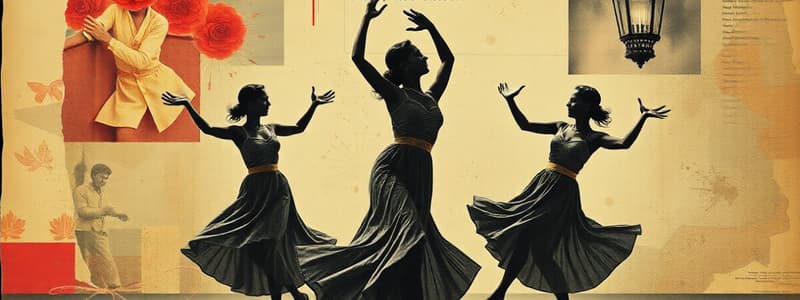Podcast
Questions and Answers
What is a general definition of dance?
What is a general definition of dance?
- The act of composing steps with grace to music. (correct)
- The act of creating visual art using paint and canvas.
- The process of writing music for a performance.
- An athletic competition involving physical strength.
According to Smith (2010), what role does dance play in human behavior?
According to Smith (2010), what role does dance play in human behavior?
- It is a fundamental element that has evolved over time. (correct)
- It serves only as entertainment.
- It is irrelevant to traditional cultures.
- It is a modern phenomenon exclusive to urban cultures.
Which of the following statements about the origins of dance is true?
Which of the following statements about the origins of dance is true?
- Dance originated solely from modern urban cultures.
- Dance has no connection to historical or ethnic traditions.
- Dance is derived from ecstatic trance states in healing rituals. (correct)
- Dance was invented for individual expression only.
What does Kassing (2007) suggest about dance?
What does Kassing (2007) suggest about dance?
Which of the following is NOT a characteristic of dance, based on the provided content?
Which of the following is NOT a characteristic of dance, based on the provided content?
How does participation in dance affect individual development?
How does participation in dance affect individual development?
According to Guha (2012), dance is primarily an expression of what?
According to Guha (2012), dance is primarily an expression of what?
What is one of the primary methods through which dance has been used historically?
What is one of the primary methods through which dance has been used historically?
What defines the 'body bases' in relation to body parts?
What defines the 'body bases' in relation to body parts?
Which term describes movements that have equal duration?
Which term describes movements that have equal duration?
What aspect of movement does 'speed' refer to?
What aspect of movement does 'speed' refer to?
In dance terms, which of the following best defines 'pathways'?
In dance terms, which of the following best defines 'pathways'?
What is a characteristic feature of classical ballet?
What is a characteristic feature of classical ballet?
Modern dance diverged from classical ballet primarily due to what?
Modern dance diverged from classical ballet primarily due to what?
Which level of space is associated with positions described as 'high'?
Which level of space is associated with positions described as 'high'?
What does 'quality' refer to in the context of movement?
What does 'quality' refer to in the context of movement?
What are considered the fundamental elements of dance?
What are considered the fundamental elements of dance?
Which of the following best describes dynamics in dance?
Which of the following best describes dynamics in dance?
Which type of movement is classified as loco-motor?
Which type of movement is classified as loco-motor?
How do physiological factors influence dance performance?
How do physiological factors influence dance performance?
What distinguishes manipulative skills from fine and gross motor skills?
What distinguishes manipulative skills from fine and gross motor skills?
What is indicated by the element 'relationship' in dance?
What is indicated by the element 'relationship' in dance?
Which factor could negatively affect an individual's performance during a dance?
Which factor could negatively affect an individual's performance during a dance?
Which is NOT one of the five major elements of dance?
Which is NOT one of the five major elements of dance?
Who was responsible for rallying the team to victory with the first organized cheer?
Who was responsible for rallying the team to victory with the first organized cheer?
In which year did the University of Minnesota allow women to cheer for the first time?
In which year did the University of Minnesota allow women to cheer for the first time?
What is the role of a 'base' in a cheerleading stunt?
What is the role of a 'base' in a cheerleading stunt?
Which organization was founded by Jeff Webb in 1974?
Which organization was founded by Jeff Webb in 1974?
Which two universities competed in the first intercollegiate game?
Which two universities competed in the first intercollegiate game?
What significant event occurred in 1948 related to cheerleading?
What significant event occurred in 1948 related to cheerleading?
Who held the first summer cheerleading clinic?
Who held the first summer cheerleading clinic?
Which university was the first to employ flashcards during cheerleading?
Which university was the first to employ flashcards during cheerleading?
What is the primary role of a spotter during a stunt?
What is the primary role of a spotter during a stunt?
Which term describes the act of returning to the floor after a stunt or routine?
Which term describes the act of returning to the floor after a stunt or routine?
What is the definition of a 'flyer' in cheerleading terminology?
What is the definition of a 'flyer' in cheerleading terminology?
What does the term 'execution' refer to in the context of cheerleading?
What does the term 'execution' refer to in the context of cheerleading?
Which of the following describes a 'pyramid' in cheerleading?
Which of the following describes a 'pyramid' in cheerleading?
Flashcards are hidden until you start studying
Study Notes
Introduction to Dance
- Dance is a performance art involving steps coordinated with music, using the body as a medium.
- Dance serves as a universal means of communication across cultures.
- Dance is accessible to all people and promotes various benefits like motor skill development, self-esteem, and social interaction.
- Dance has evolved from primitive movements to traditional and classical forms, reflecting cultural expressions and historical events.
Elements of Dance
- Dance elements are the building blocks of dance, often with one or two elements dominating in a particular style.
- The five main elements of dance are actions, body, relationship, dynamics, and space.
- Actions encompass the body's movements, guided by mechanical principles that influence how individuals move.
- Body is the tool of dance, representing the dancer's physical presence.
- Relationship refers to the interactions between dancers, dancers and objects, or even parts of a dancer's body.
- Dynamics involve qualities of movement, such as duration, energy, speed, and time, contributing to dance expressiveness.
- Space is the medium of dance, encompassing the area where the dancer moves.
Categories of Body Movements
- Loco-motor movements propel the dancer around an area, involving overall body movement.
- Non-loco-motor movements are stationary, focusing movement within a fixed location.
- Manipulative skills involve the use of hands or feet in handling equipment.
- Fine motor skills utilize the hands and fingers for precise movements.
- Gross motor skills involve larger muscle groups, often associated with individual and team sports.
Forms of Dance
- Classical Dance follows standardized rules and restrictions for structured movements.
- Classical Ballet is a highly stylized form of dance learned through specialized academies, originating in Italy and evolving in France and Russia.
- Modern Dance, deviating from the principles of classical ballet, emphasizes natural and authentic expressions of the human body and spirit.
History of Cheer Dance
- Key Individuals:
- Thomas Peebles introduced Princeton cheers to the University of Minnesota.
- Johnny Campbell organized the first organized cheer using a megaphone.
- Lawrence "Herkie" Herkimer, a Southern Methodist University cheerleader, organized the first summer cheerleading clinic.
- Jeff Webb, NCA's general manager in 1974, founded the Universal Cheerleaders Association (UCA).
- Significant Years:
- 1869: The first intercollegiate game was held between Princeton University and Rutgers University.
- 1898: Johnny Campbell organized the first organized cheer at the University of Minnesota.
- 1923: Women were allowed to cheer for the first time at the University of Minnesota.
- 1948: Lawrence Herkimer held the first summer cheerleading clinic.
- 1961: The National Cheerleaders Association (NCA) was established.
- 1974: The Universal Cheerleaders Association (UCA) was founded by Jeff Webb.
- 1987: The American Association of Cheerleading Coaches and Administrators (AACCA) was created.
- Key Schools:
- Princeton University and Rutgers University hosted the first intercollegiate game.
- The University of Minnesota was the first to allow women to cheer.
- The University of Oregon introduced the use of flashcards by cheerleaders.
- Southern Methodist University was where Lawrence Herkimer studied and cheered.
- Sam Houston State Teacher's College hosted the first summer cheerleading clinic conducted by Lawrence Herkimer.
Terminologies in Cheer Dance
-
Individuals/Members:
- Base: The person(s) on the bottom of a stunt, supporting the flyer.
- Captain: The leader of a cheerleading squad or team.
- Flier/Flyer/Floater: The person elevated in the air by the bases, on top of a stunt or pyramid.
- Spotter: The person on the ground, watching for safety hazards during stunts and ready to catch the flyer if they fall.
-
Cheer Dance Terms:
- Chant: A short, repetitive yell often accompanied by simple arm movements, typically done from the sidelines.
- Cheer: A longer yell involving movements, pom-poms, stunts, jumps, or tumbling.
- Coach: The person who instructs or teaches cheerleaders.
- Dismount: Returning to the floor position after a routine or mount.
- Execution: The performance of a stunt or routine, emphasizing its form, style, and technique.
- Mount: A skill where one or more people are supported in the air, similar to a stunt.
- Prep: The lower level of height in a stunt, where the bases hold the flyers' feet just below their chin level.
- Pyramid: A group of interconnected stunts or mounts arranged next to each other.
- Squad: A smaller group within an athletic team, organized for a specific purpose.
-
Skills:
- Jump: A coordinated movement where both feet leave the ground, involving arm and leg placements, with three phases: preparation/approach, lift, and landing.
- Stunt: A skill involving tumbling, mounting, a pyramid, or tosses.
- Tumbling: Any gymnastic skill used in cheer, dance, or for crowd appeal, executed individually or as a group in unison.
Studying That Suits You
Use AI to generate personalized quizzes and flashcards to suit your learning preferences.




